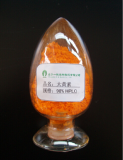Rheum Emodin
111Category: Food and Feed additives

CAS NO: 518-82-1 EC NO: 208-258-8 Molecular Formula: C15H10O5 Molecular Weight: 270.24 Specification: 98% InChI: InChI=1/C15H10O5/c1-6-2-8-12(10(17)3-6)15(20)13-9(14(8)19)4-7(16)5-11(13)18/h2-5,16-18H,1H3 Packing: Double food plastic container bag inside,aluminum foil bag outside,25kgs/drum Product description:
Plant source: dried rhizome and root of Polygonum cuspidatum Physicochemical property: Orange-yellow long needle-like crystals (yellow crystals in acetone, yellow in methanol), melting point 256 ° C to 257 ° C. Has a special reaction to cockroaches. Almost insoluble in water, soluble in ethanol and alkaline solution.Pharmacological efficacy: emodin can be used as a laxative. Although it has diarrhea activity, it is easily oxidized and destroyed. In fact, the diarrhea is weak, and if it is combined with sugar to form a glycoside, it can exert a diarrhea effect. Pharmacological action: 1, anti-tumor activity: emodin inhibits mouse solid sarcoma S-180, mouse liver cancer, breast cancer, Ehrlich ascites carcinoma, lymphosarcoma, melanoma and rat Wacker tumor and lung cancer A-549 The inhibition rate is above 30%. The inhibition rate of mouse melanoma growth was 73% at a dose of 50 mg/kg day-1; the inhibition rate of mouse breast cancer at a dose of 75 mg/kg day-1 was 45%. Emodin can prolong the survival of P388 leukemia mice with a prolongation rate of more than 40%. One of its mechanisms of action is to inhibit the biosynthesis of DNA, RNA and proteins of cancer cells and inhibit the oxidative dehydrogenation of cancer cells. 2, anti-microbial growth: emodin inhibits Staphylococcus aureus 209P, Streptococcus, Diphtheria, Bacillus subtilis, Paratyphoid bacillus, Shigella, Escherichia coli, influenza bacillus, pneumococcus, catarrhalis, etc.; It has a strong inhibitory effect on common clinical anaerobic bacteria; its MIC is slightly higher than metronidazole, and the growth of anaerobic bacteria can be inhibited by 76%~91% at 8μg/ml. The antibacterial mechanism of emodin is related to inhibition of mitochondrial respiratory chain electron transport, inhibition of respiration and oxidation and dehydrogenation of amino acid, sugar and protein metabolism intermediates. The final result of inhibiting the synthesis of nucleic acids and proteins inhibits bacterial growth. 3.Immunosuppressive effect: intraperitoneal injection of emodin at a dose of 70 mg/kg can inhibit the production of rat antibodies, inhibit the clearance of carbon particles, reduce the weight of immune organs, reduce the number of white blood cells, and reduce the phagocytosis of peritoneal macrophages. . In vitro, the concentration of [3H]-TdR and [3H]-Urd in lymphocytes at 10 mg/ml was significantly inhibited. 4, antispasmodic, antitussive effect: emodin has a strong inhibitory effect on acetylcholine-induced intestinal intestines in rats, about 4 times that of papaverine. Emodin also has a significant antitussive effect. 5,the role of the cardiovascular system: emodin has a stimulating effect on the isolated heart in small doses, while large doses have an inhibitory effect. Emodin also has a hypotensive effect. 6,diuretic effect: emodin can increase the content of sodium and potassium in the urine, promote ureteral peristalsis, increase urine output. 7. Effect on histamine: Administration of emodin to rats with experimental intestinal obstruction at a dose of 10 μg/kg can restore the histamine content of the intestinal mucosa to normal levels, but has no effect on the histamine content in the blood. 8. Synthesis of LTB4: Emodin is an inhibitor of 5-lipoxygenase, which inhibits the synthesis of LTB4 in human polynuclear leukocytes and LTB4 in whole blood, and has no inhibitory effect on the synthesis of PGE2. 9, diarrhea: emodin can inhibit the transfer of sodium and potassium ions from the intestinal lumen to the cells, so that the water stays in the intestinal lumen, stimulate the large intestine, promote its peristalsis, thereby playing a diarrhea, but the effect is weak.Uses: Food,beverage,cosmetic,chemical,medicine... Synonyms: C.I. 75440;C.I. Natural Yellow 14;1,3,8-Trihydroxy-6-methylanthraquinone;6-Methyl-1,3,8-trihydroxyanthraquinone;emodin from frangula bark; Molecular Structure: 
if you are sourcing Rheum Emodin from China ,just feel free to inquire



